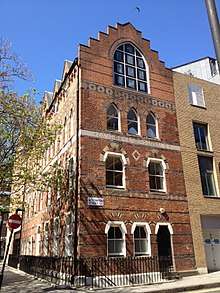Lavers, Barraud and Westlake
Lavers, Barraud and Westlake were an English firm that produced stained glass windows from 1855 until 1921. They were part of the Gothic Revival movement that affected English church architecture in the 19th century.[2][3]

History
In the mid 19th century, Lavers, Barraud and Westlake were among many young designers who responded to the growing market for stained glass windows. The partnership initially comprised Nathaniel Wood Lavers (1828–1911) and Francis Philip Barraud (1824–1900)[note 1] and operated from 1858 as Lavers and Barraud. Both were originally employed at the workshops of James Powell and Sons. Lavers started his own studio in 1855 and was joined by Barraud in 1858. A freelance artist, Nathaniel Westlake (1833–1921), joined them as a partner in 1868, having worked with the architect, William Burges and with Alfred Bell of Clayton and Bell.
The company used a number of freelance artists apart from Westlake. These included Henry Stacy Marks (1829–1898) who designed windows with elongated medievalising figures for the company in its earliest years and J.M. Allen who worked with Lavers and Barraud before the joining of Westlake, also designing windows for the firms of Heaton, Butler and Bayne, and Shrigley and Hunt until the 1880s. Alfred Bell (1832–95) and Henry Holiday also designed glass for Lavers, Barraud and Westlake.
Between 1891 and 1894 Nathaniel Westlake published four volumes entitled "A History of Design in Painted Glass". After the deaths of Barraud in 1900 and Lavers in 1911, Westlake became the sole partner, continuing in business until his death in 1921.
Note
- younger brother of William Barraud and Charles Decimus Barraud, descendants of a French Huguenot family of watch and clockmakers
References
- Historic England. "NUMBER 22 AND ATTACHED RAILINGS (1078289)". National Heritage List for England. Retrieved 8 September 2014.
- Gordon Campbell The Grove Encyclopedia of Decorative Arts, Volume 2, p.21
- Stained Glass in Wales, accessed May 16, 2012.
See also
- Stained glass
- Stained glass - British glass, 1811-1918
- Victorian Era
- Gothic Revival
External links
| Wikimedia Commons has media related to Lavers & Barraud. |